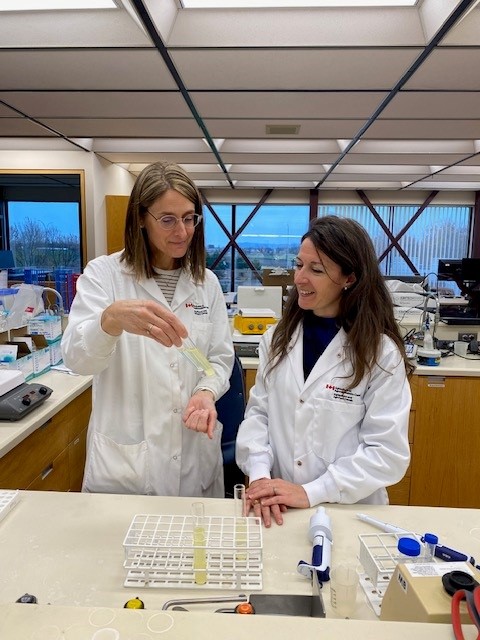For further information
Media Relations
Agriculture and Agri-Food Canada
1-866-345-7972
aafc.mediarelations-relationsmedias.aac@agr.gc.ca
Did you know that raw material lost from cheese-making has a potential for reuse? These nutrient-rich elements or liquids are mainly reused as fertilizer in the fields. But we can do even better with this food residue.
At Agriculture and Agri-Food Canada’s Saint-Hyacinthe Research and Development Centre, research scientist Marie-Claude Gentès has found a way to reuse milk permeate—the liquid from cheese production—to make a sports drink. The goal of her research project is to limit food waste by finding ways of using all the components of food.
Recycling milk permeates
Marie-Claude Gentès’ team carries out its research using liquid from cheese-making. This liquid is made up of ultrafiltration permeates from milk and whey. They are nonfat milk solids.
“To develop innovative products from food residues, you first need to know the raw material well. In the case of this research, we needed to know how permeates behave according to different treatments used in the dairy industry.”
- Marie-Claude Gentès, Research Scientist, Agriculture and Agri-Food Canada
The scientist transforms this residue, making it safe by using heat treatment to kill off dangerous bacteria. One of the best-known heat treatments is pasteurization. Various studies on milk have shown that heat treatments affect the product’s aroma and taste. Some of them can even cause sedimentation in the liquid, which would limit its use in sports drinks. So, it’s time to find the right recipe!
A more complex recipe than you might imagine
Marie-Claude Gentès’ objective was to find the ideal heat treatment to create a sports drink from the liquid produced by cheese production. However, beyond heat treatment, she learned that several other aspects can influence the result. She noted that the type of cheese produced, cheese-making practices, storage and processing conditions are among the factors that can introduce significant variations in the composition of the liquid. In addition to the intensity of heat treatment, pH is one of the factors that have a significant effect on product stability.
In addition to product stability, the desired attributes of such beverages include being rich in electrolytes and antioxidants. Electrolytes facilitate the entry of nutrients into cells and the evacuation of waste products from them. They maintain the body’s fluid balance and enable muscles to function properly. Antioxidants are molecules that protect our cells by neutralizing free radicals. In other words, they reduce cell damage and aging.
The study also showed that processing heat must be carefully selected to optimize the product’s properties for the formulation of sports drinks. The study raised the issue of whether such permeate-based beverages can be enriched with omega-3 fatty acids, or whether it is possible to convert the product’s natural sugar into fiber. They could be very attractive options for making the product even more nutritious.
Future work will therefore be needed to better understand how the composition and treatment of parameters, such as thermal intensity and pH, affect the sensory properties of permeates and their evolution during the production and storage.
“Cheese production generates a large quantity of residues that need to be recycled. The aim of this project was to provide new knowledge to help the industry develop value-added dairy products, and to reduce the amount of food waste generated by cheese production in a circular economy.”
- Marie-Claude Gentès, Research Scientist, Agriculture and Agri-Food Canada
Sports enthusiasts, stay tuned! Marie-Claude Gentès is continuing her research, and you may soon find a new drink on store shelves that will not only support you in your sporting activities, but also help reduce food waste.

Scientific researcher Marie-Claude Gentès and her research assistant Sophie Lamothe work in the laboratory on their research project.